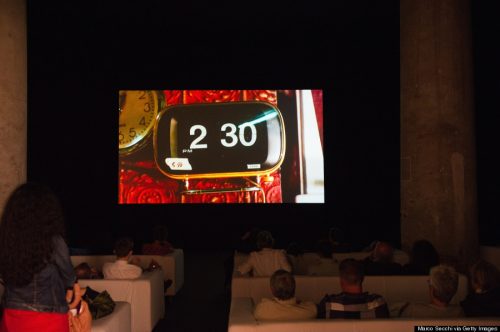
All in Good Time
My two Spring semesters in the Interdisciplinary Arts & Media program at Columbia so far have differed markedly from their preceding Fall semesters. That is, there is something about the passage and perception of time that seems to transform from Fall to Spring. Fifteen weeks, normally such a long expanse, feel as if they compress into five. Though, admittedly, time always seems in short supply in grad school, this feeling is heightened in the Spring semester. Case in point, now. Here I am, mere weeks into the semester, and in anything but a beginning-of-semester calm. Instead, it is already a frenetic, dynamic, and shifting mix of reading, researching, planning, making, and reflecting.

Illustrating precisely how I am not perceiving time–with total accuracy: “Visitors watch the video installation ‘The Clock’ by Christian Marclay winner of the Golden Lion for the Best Artist at ILLUMInation Exhibition on June 7, 2011 in Venice, Italy.” (Photo by Marco Secchi/Getty Images)
I suppose this can, at least in part, be attributed to Spring’s being a “continuation” in contrast to Fall’s “blank slate.” Everything that emerges as an interest intellectually and conceptually in the previous semester must now be investigated more deeply, examined, and questioned further. Additionally, not-so-distant Spring critique dates linger in the back of 1st- and 2nd-year MFA students’ minds, and the proposition of organizing what is presently a cacophonous assortment of thoughts into an articulate, considered, and meaningful discourse with your peers and mentors seems a daunting one. So, in an effort to move in the general direction of eventual organization, I think I’ll use this space to attempt to compartmentalize what that assortment of thoughts is for me at this moment:
Teaching, in Theory and Practice
So–to begin with–as I mentioned in my previous post, I am an Instructor of Record for the first time ever this semester, teaching Drawing for Non-Majors to Columbia undergraduates. Concurrently, I am enrolled in the graduate teaching seminar. As you can imagine, teaching alongside learning about teaching is a unique position to be in. It’s reaffirming to have a professor that is a readily available resource for a first-time studio instructor, while it’s also inevitable that some amount of the teaching practice will be learned through doing. As much as you may anticipate, labor, and prepare, teaching real students has some inherent unpredictability. That element of chance and the adaptability it requires have presented a rewarding challenge to me so far this semester.
Looking (Inward) to Express (Outward)
Through my other courses this semester–Art as Spiritual Practice and Directed Graduate Projects–I am challenging myself to break a bit from my compulsion to constantly make, pausing to consider and strengthen my understanding of the “why” of my work. I’m trying, more deliberately, to extract and name the things that are running through my artistic practice. While at times this can feel like an existential crisis (mostly joking), I think it will ultimately enrich my artistic practice, which is the great goal in pursuing a Master of Fine Arts program in my view. In these courses, my professors Onur Ozturk and Sabina Ott offer different backgrounds and perspectives–as art historian and artist, respectively–which I feel unbelievably lucky to have.
Multiple Ways In
Now more than ever, as I start to see the faintest traces of my third and final year ahead, I am trying to make good use of the varied perspectives available from Columbia’s faculty, staff, and my peers. As with Onur and Sabina, I want to get as much perspective from as many sources as possible in order to make my art the best version of itself and–in turn–gain not only external clarity but also self-knowledge.
With that said, I leave you to continue on my trek of reading, thinking, making, and reaching out!
